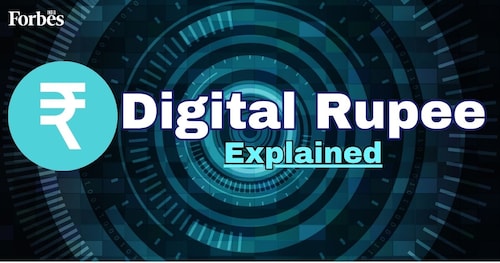Digital rupee (e₹): What is it and how does it work
Let's talk about Digital Rupee, India's digital currency. We'll look at its features, benefits and drawbacks. We'll also understand how it differs from crypto


India is at the forefront of a digital payments revolution. Thanks to innovations like UPI (Unified Payments Interface), cashless transactions have become the norm for millions of Indians. It is no surprise that India is among the largest digitalised countries in the world. The latest buzz in the digital payments landscape surrounds its Central Bank Digital Currency (CBDC). Countries worldwide are launching the digital version of their legal tender, and India is not behind. The Reserve Bank of India (RBI) is working on the launch of India’s CBDC, the Digital rupee.
In this article, we will understand all there is to know about Digital Rupee.
Digital Rupee, also called E-Rupee, denominated as e₹ or eINR, is a tokenised digital version of the Indian Rupee issued and regulated by the RBI. It is built using blockchain distributed-ledger technology.
Similar to physical banknotes, India’s digital currency would function as a means of payment, a measure of value, and a store of value. Each unit of e₹ would be uniquely identifiable to prevent counterfeiting, a security feature also present in physical currency. The Indian e-currency is a part of the base money supply and, as such, is a liability of the RBI, just like physical currency.
RBI plans to launch e₹ in two forms:
The Digital Rupee (Indian e-currency) is an example of a CBDC. Let’s understand the difference between a CBDC and a Digital Rupee:
CBDC refers to the digital form of a country"s official currency, issued and controlled by its central bank. It functions similarly to physical notes and coins the only difference is that it exists in digital form.
The Digital Rupee is India"s CBDC. It"s a digital version of the Indian rupee, regulated by the RBI.
RBI has launched pilot programs to test e₹. Let’s learn about them:
Here’s the working mechanism of Digital Rupee:
RBI will create electronic tokens in the same denomination as regular rupees. These tokens can be swapped for physical cash. Instead of dealing with the hassle of printing, storing, and transporting physical cash, the RBI will distribute these digital tokens electronically through intermediaries called Token Service Providers (TSPs). Banks will then acquire the Indian e-currency tokens from the RBI through these TSPs.
Once banks have received the tokens, they can directly credit your e₹ wallet with digital tokens. This process will be similar to topping up a debit card. Users will be able to convert existing cash holdings into e₹ through the UPI platform. There will also be an option for instantaneous transfers from your bank account directly to your e₹ wallet.
One of the main benefits of the e₹ is cost savings. The switch to digital currency could eliminate approximately ₹5,000 crore currently spent annually on printing physical rupees. Unlike traditional methods that rely on intermediaries like banks and clearing houses, CBDCs enable real-time, direct transfers from payer to payee. The funds would move directly from your digital e₹ wallet to the store"s e₹ wallet, eliminating the need for intermediaries. This approach offers benefits such as:
While the digital currency offers many advantages, it suffers from some drawbacks as well, including:
Here is how cryptocurrency and Digital Rupee differ:
Cryptocurrency: Cryptos are decentralised digital assets that any government or central bank does not back. They operate on blockchain technology and offer anonymity.
Digital Rupee: A CBDC issued and controlled by the RBI, it operates on blockchain technology and is a digital alternative to physical rupees.
As of March 2024, over 134 countries, representing 98 percent of global GDP, are at various stages of exploring CBDC implementation.
Major economies like the US, EU, and UK are actively involved in this research. Amongst these, China is the first to launch a CBDC: Digital RMB.
Other than China, five central banks have already launched their CBDCs, including the Bahamas (Sand Dollar), Eastern Caribbean (DCash), Nigeria (e-Naira), Jamaica (JamDex) and India (Digital Rupee).
Brazil and Russia are conducting pilot tests for their digital currencies (Drex and Digital Ruble, respectively).
The European Central Bank (ECB) is working on launching the Digital Euro.
1. Which banks have participated in RBI’s Digital Rupee?
Banks participating in RBI’s Digital Rupee program include the State Bank of India, Yes Bank, IDFC First Bank, Union Bank of India, HDFC Bank, and many more.
2. Does the new 30 percent tax on crypto assets include the E-rupee?
No. The E rupee is a government-issued digital currency, not a cryptocurrency. The 30 percent tax targets unregulated crypto assets.
First Published: Aug 22, 2024, 17:48
Subscribe Now